Demand Generation vs Lead Generation: Strategic Differences
Key Strategic Differences to Drive Sustainable B2B Growth
Blogby JanAugust 10, 2025

B2B marketers face a persistent challenge: balancing immediate pipeline needs with sustainable growth strategies. This tension often manifests in confusion between demand generation and lead generation — two approaches that sound similar but serve fundamentally different purposes in driving business growth.
Research shows that B2B buyers complete 69% of their purchasing process before engaging with sellers. This reality has profound implications for how organizations approach their marketing strategy. Companies that understand the distinction between creating demand and capturing leads consistently outperform those treating these strategies as interchangeable.
The difference matters more than many realize. Organizations that properly balance demand generation and lead generation report 15% higher quota attainment and 20% faster sales cycles compared to those using unfocused approaches.
The Mix-Up That's Costing You Deals
Marketing leaders often treat demand generation and lead generation as the same thing because they share common elements: both target B2B audiences, both use content marketing, and both aim to drive revenue growth. But this surface similarity masks critical strategic differences.
The confusion typically starts with metrics. Sales teams pressure marketing for "more leads" while executives ask for "demand generation results." Marketing teams respond by creating campaigns that try to serve both masters simultaneously — ungated content that somehow needs to produce immediate contacts, or gated assets that attempt to build long-term brand awareness.
This mixed approach satisfies neither objective effectively. You end up with demand generation campaigns that fail to build meaningful brand recognition and lead generation efforts that produce low-quality contacts because insufficient groundwork was laid.
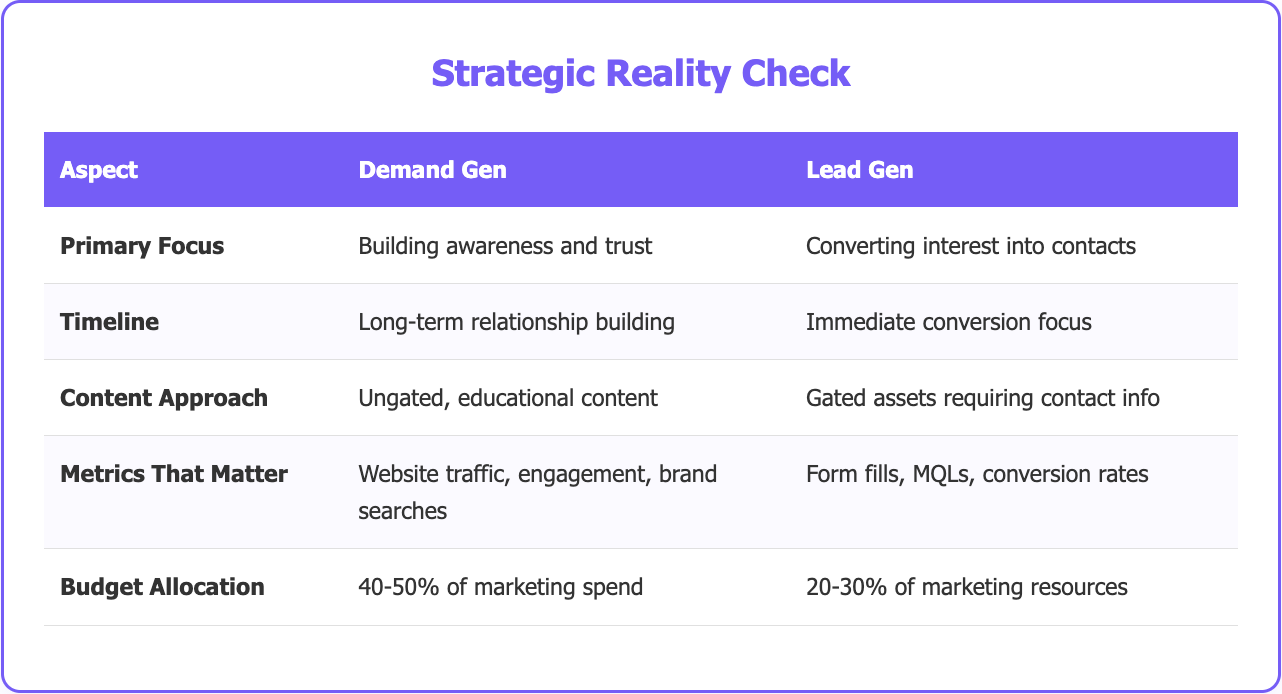
Consider how most B2B software companies approach a product launch. They create a whitepaper about their new solution, gate it behind a form, promote it through paid ads, and expect both brand awareness and qualified leads. The result? Modest form submissions from people not ready to buy, and missed opportunities to educate a broader market about problems they solve.
Demand Gen: Playing the Long Game
Demand generation focuses on creating awareness and interest before someone knows they need your solution. It's the process of educating your market about problems they might not realize they have and positioning your organization as a trusted source of expertise.
Think of demand generation as farming rather than hunting. You're planting seeds, nurturing growth, and creating conditions for future harvest. The timeline is months or years, not weeks. The goal is mindshare, not immediate pipeline.
Why Most People Aren't Ready to Buy
Demand generation addresses a fundamental B2B reality: most of your potential customers aren't actively shopping for your solution at any given moment. Studies consistently show that only 2-5% of your total addressable market is "in-market" and ready to buy today.
The remaining 95-98% includes:
- People who don't know they have a problem you solve
- Organizations aware of the problem but not prioritizing a solution
- Companies researching solutions but not ready to engage vendors
- Buyers early in their education process
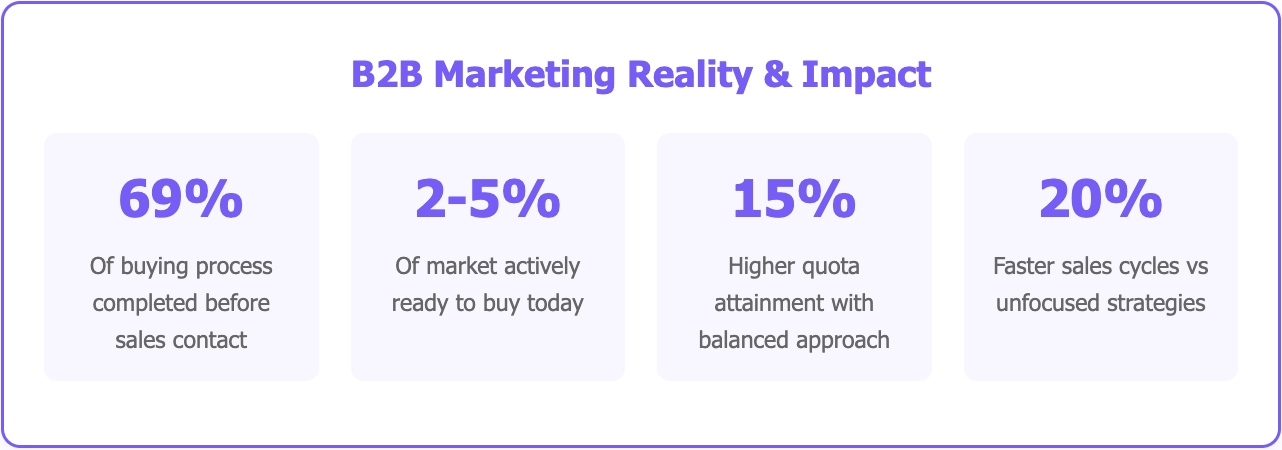
Effective demand generation targets this broader population, gradually moving them toward readiness to consider solutions like yours. The process involves educating prospects about industry challenges, sharing insights about emerging trends, and establishing your organization's credibility and expertise.
Content That Doesn't Ask for Anything
Demand generation content is typically ungated and freely accessible. The goal is maximum consumption and sharing, not contact capture. Common formats include:
Educational blog content that addresses industry challenges without promoting specific solutions. A cybersecurity company might publish articles about emerging threat landscapes, compliance requirements, or security best practices — all valuable to their audience regardless of purchase intent.
Thought leadership from company executives sharing perspectives on industry trends, market dynamics, or business strategy. These pieces establish the organization as forward-thinking and knowledgeable.
Industry research and reports that provide valuable insights to practitioners in your field. Smart demand generation teams conduct original research, survey their market, and publish findings that become reference materials for their industry.
Podcasts and webinars featuring subject matter experts discussing relevant topics. The focus is education and insight-sharing rather than product promotion.
Social media engagement that demonstrates expertise through helpful responses to industry discussions, insightful commentary on market developments, and participation in professional community conversations.
The common thread is value creation without asking for anything in return. You're building a relationship based on expertise and helpfulness, not transaction pressure.
Tracking Progress Without Forms
Traditional lead generation metrics don't apply to demand generation campaigns. Instead, focus on indicators of growing awareness and engagement:
Brand search volume shows whether more people are looking for your company specifically. Growing organic searches for your brand name indicate successful awareness building.
Website traffic growth particularly to educational content and thought leadership pieces. Pay attention to time on page, pages per session, and return visitor rates.
Content engagement across channels. Are people sharing your content? Commenting on social posts? Attending webinars without being prompted by sales outreach?
Social media following and engagement growth in professional networks where your audience congregates. LinkedIn follower growth and engagement rates are particularly relevant for B2B.
Inbound pipeline development over time. As demand generation efforts mature, you should see increased inbound interest from prospects who discovered you through educational content.
Market presence indicators like speaking opportunities, media mentions, analyst recognition, and industry award nominations. These suggest your thought leadership is gaining traction.
Lead Gen: Going After Ready Buyers
Lead generation operates under a different assumption: demand already exists, and your job is capturing and qualifying interested prospects. Lead generation targets people showing buying intent or demonstrating readiness to evaluate solutions.
If demand generation is farming, lead generation is harvesting. You're identifying ripe opportunities and gathering the information needed to pursue them effectively.
Finding People Who Want to Buy Now
Lead generation campaigns target the 2-5% of your market that's actively in buying mode. These prospects:
- Recognize they have a problem requiring external solutions
- Have budget allocated or approval to spend on addressing the issue
- Are actively researching vendors and solutions
- Demonstrate intent through specific behaviors or inquiries
Effective lead generation focuses on these high-intent prospects, offering valuable resources in exchange for contact information and qualification details. The goal is identifying sales-ready opportunities that can move quickly through your pipeline.
Content Worth Trading Contact Info For
Lead generation content is almost always gated — requiring contact information for access. The value proposition must be compelling enough to justify the "cost" of providing personal details. Effective formats include:
In-depth guides and whitepapers that address specific implementation challenges or provide detailed solutions to known problems. A marketing automation company might offer "The Complete Guide to Lead Scoring Implementation" — highly valuable to someone actively building lead management processes.
Case studies and ROI calculators that help prospects build business cases for solutions like yours. These resources appeal to people already convinced they need a solution and trying to justify the investment.
Product demos and free trials for prospects ready to evaluate specific tools. The lead quality is typically high because requesting access indicates genuine interest and near-term purchase intent.
Webinars and workshops focused on solution implementation rather than problem education. Topics like "Advanced Configuration Techniques" or "Integration Best Practices" attract people already using or seriously considering your type of solution.
Assessment tools that help prospects evaluate their current situation and identify improvement opportunities. These work well because they provide personalized insights while gathering qualification information.
The key difference is transactional value exchange. Prospects provide contact information because the content offers immediate, actionable insights they need for current initiatives.
Numbers That Actually Mean Something
Lead generation success is measured by contact acquisition and qualification outcomes:
Conversion rates from various traffic sources to form submissions. Track which channels, content types, and campaigns generate the highest conversion rates.
Lead volume and quality scores based on fit with your ideal customer profile. High volume means nothing if the leads don't match your target market or show genuine intent.
Marketing Qualified Lead (MQL) rates from initial form submissions. What percentage of contacts meet your criteria for sales follow-up?
Sales Qualified Lead (SQL) conversion from marketing qualified leads. How effectively do your lead generation efforts identify prospects ready for sales conversations?
Pipeline contribution from lead generation campaigns. Track revenue generation from contacts acquired through specific campaigns or content assets.
Cost per lead and customer acquisition cost to ensure efficient resource allocation across lead generation activities.
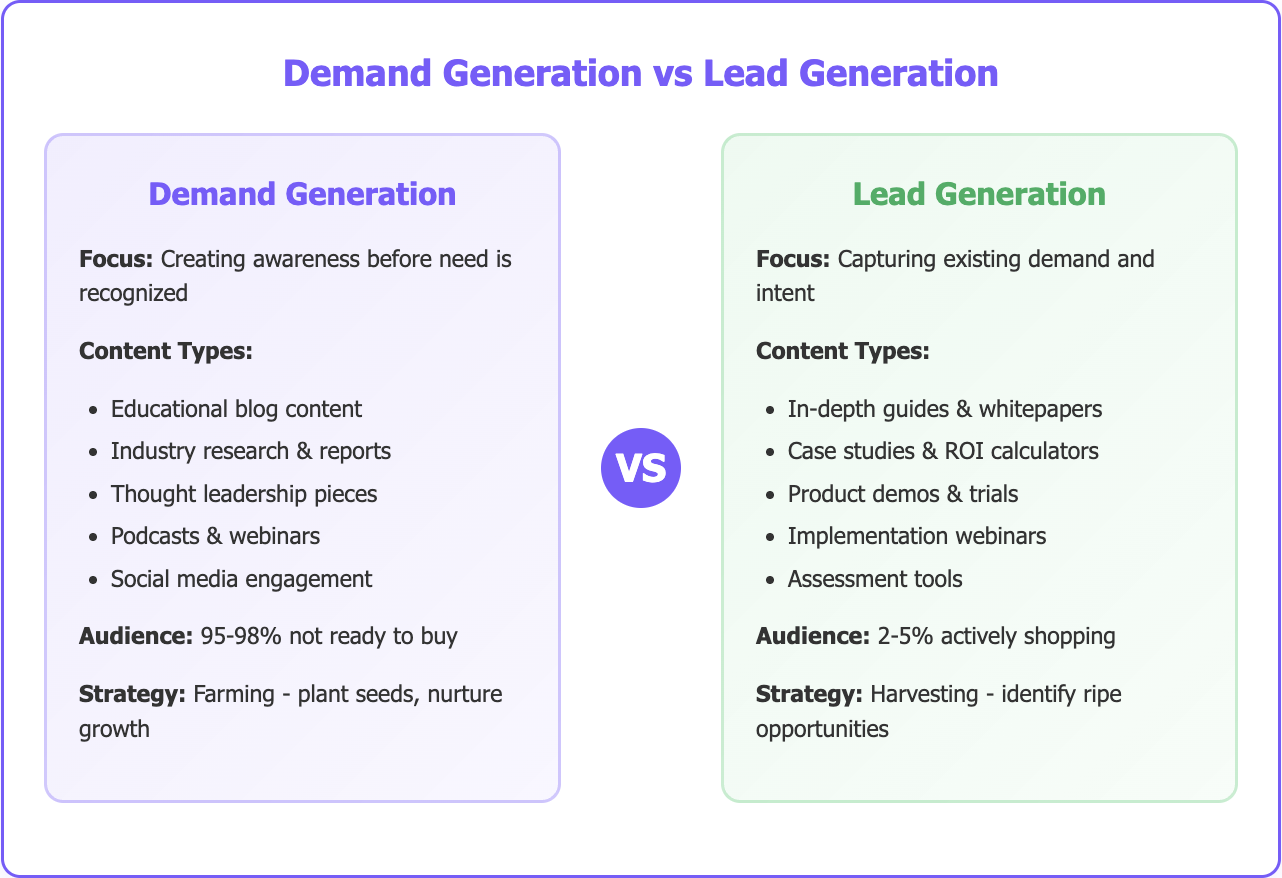
The Decisions That Trip Everyone Up
To Gate or Not to Gate
The most common point of confusion involves content gating decisions. Teams frequently gate content that should be freely accessible or create ungated content that could generate valuable lead information.
Gate content when:
- The audience has demonstrated buying intent
- The content provides specific implementation guidance
- The information offers significant competitive advantage
- The resource requires ongoing support or updates
Don't gate content when:
- You're building general market awareness
- The goal is establishing thought leadership
- The content addresses early-stage problem recognition
- Maximum distribution is more valuable than contact capture
A practical test: Would someone already aware of your company and interested in your solutions still find this content valuable? If yes, consider gating. If the content's value lies in educating people who don't know you exist, keep it ungated.
When Results Actually Show Up
Demand generation and lead generation operate on completely different timescales, creating unrealistic expectations when teams don't distinguish between them.
Demand generation results compound over time. Early efforts may show minimal immediate impact while building foundational awareness that pays dividends months or years later. Successful demand generation requires patience and consistent investment before significant results become apparent.
Lead generation can produce immediate results when targeting existing demand. Well-executed lead generation campaigns often show positive outcomes within weeks of launch, especially when targeting high-intent audiences.
The mistake is expecting demand generation to produce immediate pipeline or assuming lead generation can create demand where none exists. Each serves different purposes on different timelines.
Where to Spend Your Marketing Budget
Organizations often allocate budgets without considering the distinct requirements of demand generation versus lead generation activities.
Demand generation typically requires larger upfront investments in content creation, thought leadership development, and brand building activities. The ROI timeline is longer, but the ultimate impact on market position and pipeline quality can be significant.
Lead generation can operate with smaller, more targeted investments focused on specific campaigns or content assets. Results are typically faster and more directly measurable, making budget justification easier.
Smart organizations allocate approximately 40-50% of marketing budget to demand generation activities and 20-30% to lead generation, with the remainder supporting general marketing operations and campaign infrastructure.
Getting Both to Work Together
The most effective B2B marketing strategies integrate demand generation and lead generation rather than treating them as competing approaches. They work together in a natural progression that maximizes both immediate pipeline and long-term market position.
The Natural Progression
Start with demand generation to build market awareness and establish credibility with your target audience. Invest in educational content, thought leadership, and industry engagement that demonstrates expertise without asking for anything in return.
Monitor engagement signals to identify prospects showing increased interest or buying intent. Look for behaviors like repeated website visits, content consumption patterns, or social media engagement that suggest growing interest.
Transition engaged prospects to lead generation by offering more specific, solution-oriented content in exchange for contact information. The transition should feel natural — people who have consumed your educational content are more likely to provide contact details for implementation-focused resources.
Nurture leads with continued value rather than immediate sales pressure. The goal is maintaining engagement and building trust until prospects are ready for sales conversations.
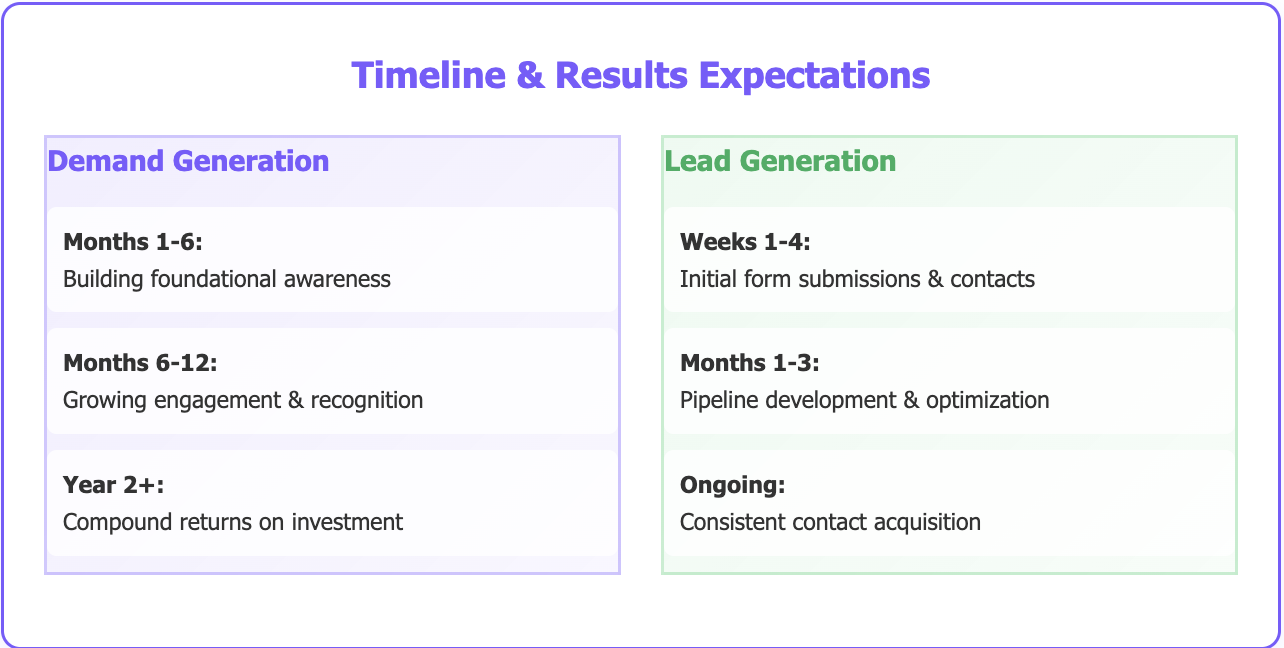
Content That Pulls Double Duty
Some content types effectively serve both demand generation and lead generation purposes:
Multi-format content series that begins with ungated educational content and progresses to gated implementation resources. Start with blog posts about industry challenges, follow with ungated guides about solution approaches, then offer gated templates or tools for implementation.
Webinar series where the initial sessions are ungated and educational, building audience and demonstrating expertise. Later sessions can be gated and focus on specific implementation topics that require contact information for access.
Progressive profiling allows you to gather contact information gradually rather than requesting extensive details upfront. Start with minimal gating (email address only) for mid-funnel content, then request additional qualification information for bottom-funnel resources.
The Tech That Connects Everything
Modern marketing technology enables seamless integration between demand generation and lead generation activities:
Marketing automation platforms can track prospect engagement across ungated content and automatically trigger lead generation campaigns when engagement levels suggest buying intent.
Lead scoring systems combine demand generation engagement (content consumption, website visits, social engagement) with lead generation actions (form submissions, demo requests) to identify sales-ready prospects.
Account-based marketing tools can identify anonymous website visitors who engage with demand generation content and trigger targeted lead generation campaigns to key accounts.
At Databar.ai, we've seen organizations dramatically improve their results by connecting demand generation insights with lead generation execution. Our platform helps identify prospects consuming educational content and automatically enriches their profiles with relevant data, enabling personalized lead generation campaigns that feel natural rather than intrusive.
Knowing Which Approach to Use When
Times When Demand Gen Is Your Best Bet
New market education: When you're introducing innovative solutions or addressing problems people don't recognize, demand generation is essential. You need to educate the market about the problem before anyone will seek solutions.
Competitive differentiation: In crowded markets where buyers know solutions exist but aren't sure how to evaluate them, demand generation helps establish your unique perspective and expertise.
Long sales cycle preparation: Complex B2B purchases often involve 6-18 month evaluation processes. Demand generation keeps your organization visible and credible throughout extended decision cycles.
Relationship building: When success depends on trust and credibility — common in professional services, consulting, or high-value technology solutions — demand generation builds the foundation for eventual sales conversations.
Times When Lead Gen Makes More Sense
Known problem categories: When your target market clearly understands they need solutions like yours, lead generation efficiently identifies and qualifies interested prospects.
High purchase intent: Lead generation works best when targeting prospects already researching solutions, comparing vendors, or actively budgeting for purchases.
Short sales cycles: Transactional B2B sales with shorter evaluation periods benefit from lead generation's direct approach to capturing and qualifying interested prospects.
Mature markets: In established solution categories where buyer education isn't necessary, lead generation efficiently captures and converts existing demand.
Setting Up Your Own Strategy
Figure Out Where You Stand
Start by honestly evaluating your market position and target audience awareness:
Market maturity: How well does your target audience understand the problems you solve? Newer problem categories require more demand generation investment; established categories can focus more heavily on lead generation.
Brand recognition: Unknown brands need demand generation to build credibility and awareness. Established brands can allocate more resources to lead generation activities.
Competition analysis: In crowded markets, demand generation helps differentiate your approach. In less competitive spaces, lead generation may be sufficient to capture available demand.
Sales cycle length: Longer sales cycles benefit from demand generation's relationship-building approach. Shorter cycles can focus more heavily on lead generation's immediate conversion focus.
How to Split Your Time and Money
Effective integrated strategies allocate resources based on current needs and strategic objectives:
Startup or unknown brands: 70% demand generation, 30% lead generation. Focus on building awareness and credibility before expecting significant lead volume.
Established companies entering new markets: 60% demand generation, 40% lead generation. Use brand recognition to support market education efforts while capturing existing demand.
Mature organizations in known markets: 40% demand generation, 60% lead generation. Maintain thought leadership while focusing on converting available demand.
Market leaders: 30% demand generation, 70% lead generation. Use market position to efficiently capture demand while maintaining thought leadership.

Mapping Out Your Content
Plan content that serves both strategies without confusing their purposes:
Educational content calendar that builds industry expertise through ungated resources. Focus on problem awareness, trend analysis, and best practice sharing.
Solution-focused content series that targets high-intent prospects with gated resources. Emphasize implementation guidance, ROI analysis, and competitive comparisons.
Progressive content journeys that move prospects from problem awareness (demand generation) to solution evaluation (lead generation) through logical content progression.
The Tools You Actually Need
Successful integration requires technology that supports both strategies:
Content management systems that can easily gate and ungate content based on campaign objectives and audience targeting.
Marketing automation platforms with sophisticated lead scoring and nurturing capabilities that incorporate both engagement tracking and contact acquisition.
Analytics tools that measure both brand awareness metrics (traffic, engagement, social reach) and conversion metrics (leads, pipeline, revenue).
Customer data platforms that create unified profiles combining anonymous engagement data with known prospect information.
Tools like Databar.ai help bridge demand generation and lead generation by automatically enriching prospect profiles with comprehensive data, enabling personalized campaigns that feel natural rather than intrusive.
Advanced Integration Techniques
Intent Signal Integration
Modern B2B marketing can identify prospects showing buying intent through various behavioral signals, creating opportunities to transition prospects from demand generation to lead generation seamlessly.
Website behavior tracking identifies prospects consuming multiple pieces of educational content or returning frequently to solution-focused pages. These behavioral patterns suggest growing interest that may justify lead generation follow-up.
Social media engagement monitoring can identify prospects engaging with your thought leadership content across multiple platforms. Consistent engagement suggests brand affinity that makes lead generation campaigns more likely to succeed.
Third-party intent data identifies prospects researching solution categories or competitors. These signals suggest active market evaluation that warrants immediate lead generation attention.
Content consumption patterns reveal prospects moving from general educational content toward specific implementation resources. This progression indicates readiness for lead generation engagement.
Account-Based Integration
Account-based marketing approaches can effectively combine demand generation and lead generation by targeting specific accounts with coordinated campaigns across multiple stakeholders.
Account-level demand generation involves creating educational content and thought leadership that builds awareness across entire buying committees. Focus on industry challenges and strategic initiatives rather than specific solutions.
Stakeholder-specific lead generation targets individual decision-makers within target accounts with relevant resources based on their role and interests. Tailor content to specific functions (IT, finance, operations) and decision-making responsibilities.
Progressive engagement moves target accounts through coordinated touchpoints that build awareness and credibility before requesting contact information or meetings.
Marketing Technology Integration
Advanced marketing technology stacks can automatically coordinate demand generation and lead generation activities based on prospect behavior and characteristics.
Dynamic content personalization shows different content versions based on prospect engagement history. Anonymous visitors see demand generation content; known prospects with high engagement scores see lead generation offers.
Automated campaign triggers launch lead generation sequences when prospects demonstrate specific engagement thresholds with demand generation content.
Cross-channel orchestration coordinates messaging across email, social media, advertising, and direct mail to create consistent experiences that support both demand generation and lead generation objectives.
Measuring Success Across Both Strategies
Holistic Attribution
Understanding the connection between demand generation and lead generation requires attribution models that track prospect journeys across multiple touchpoints and time periods.
Multi-touch attribution credits both demand generation touchpoints (blog visits, social engagement, webinar attendance) and lead generation actions (form submissions, demo requests) in conversion paths.
Time-delay analysis measures the lag time between demand generation engagement and eventual lead generation conversion, helping optimize campaign timing and resource allocation.
Content journey mapping identifies which combinations of demand generation and lead generation content most effectively move prospects toward purchasing decisions.
Integrated Reporting
Successful organizations report on demand generation and lead generation performance both separately and collectively:
Individual strategy performance measures each approach against its specific objectives — awareness and engagement for demand generation, contact acquisition and qualification for lead generation.
Combined strategy impact evaluates how effectively the integrated approach builds pipeline, shortens sales cycles, and improves deal quality compared to single-strategy approaches.
Resource efficiency analysis compares the cost and time investment required for different combinations of demand generation and lead generation activities.
Your Next Steps
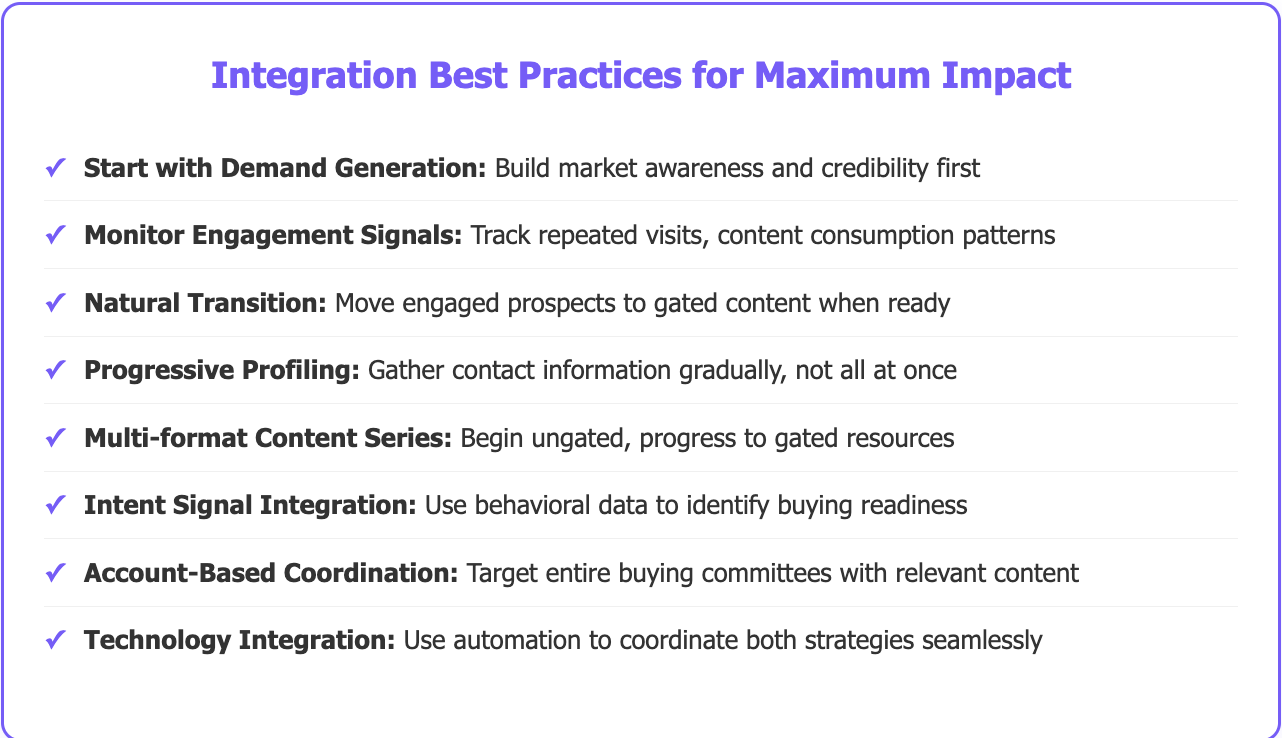
Immediate Actions
Audit your current content to identify which pieces serve demand generation versus lead generation purposes. Ensure you have appropriate content for both strategies.
Evaluate gating decisions for existing content assets. Consider ungating educational content that could build broader awareness and reach.
Review metrics and reporting to establish separate measurement frameworks for demand generation and lead generation activities.
Assess technology capabilities for tracking prospect engagement across both strategies and identifying opportunities for seamless transitions between them.
Strategic Planning
Define your market position and buyer awareness levels to determine optimal resource allocation between demand generation and lead generation.
Establish timeline expectations for both strategies, ensuring stakeholders understand the different ROI curves and success metrics.
Plan integrated campaigns that coordinate demand generation and lead generation activities rather than treating them as separate initiatives.
Build cross-functional alignment between teams responsible for demand generation (often marketing) and lead generation (often marketing and sales) to ensure coordinated execution.
The distinction between demand generation and lead generation isn't academic — it's fundamental to building sustainable B2B growth strategies. Organizations that master both approaches and integrate them effectively consistently outperform those using single-strategy approaches or treating these distinct methodologies as interchangeable.
Success requires understanding that demand generation builds the foundation for long-term market position while lead generation captures immediate opportunities. Neither strategy alone is sufficient, but together they create powerful competitive advantages that drive both immediate pipeline and sustainable growth.
Frequently Asked Questions
Should I focus on demand generation or lead generation first?
This depends on your market position and brand awareness. Unknown brands should prioritize demand generation to build credibility and awareness before expecting significant lead volume. Established brands in known markets can focus more heavily on lead generation. Most organizations need both, but resource allocation should reflect current market position and strategic objectives.
How do I know when to gate content versus keeping it free?
Gate content when your audience has demonstrated buying intent and the content provides specific implementation value. Keep content ungated when building general market awareness or establishing thought leadership. A practical test: would someone already interested in your solutions find this content valuable enough to provide contact information? If yes, consider gating.
What's the typical timeline for seeing results from each strategy?
Lead generation can produce immediate results within weeks when targeting existing demand. Demand generation typically requires 6-12 months of consistent effort before significant awareness and engagement improvements become apparent. The key is setting appropriate expectations and measurement frameworks for each strategy's natural timeline.
How much budget should I allocate to each approach?
Resource allocation depends on market maturity and brand recognition. Startups typically need 70% demand generation, 30% lead generation. Established companies in new markets might use 60% demand generation, 40% lead generation. Mature organizations in known markets often allocate 40% demand generation, 60% lead generation. Market leaders may use 30% demand generation, 70% lead generation.
Can the same content serve both demand generation and lead generation?
Some content can serve both purposes through progressive gating or multi-format series. Start with ungated educational content that builds awareness, then offer gated implementation resources to engaged prospects. The key is ensuring each piece serves its primary purpose effectively rather than compromising both objectives.
What technology do I need to integrate demand generation and lead generation?
Essential tools include marketing automation platforms with lead scoring capabilities, content management systems that support flexible gating, analytics tools that measure both awareness and conversion metrics, and customer data platforms that create unified prospect profiles. Advanced platforms like Databar.ai can help bridge both strategies by automatically enriching prospect data and enabling personalized campaigns.
How do I align sales and marketing around both strategies?
Establish clear definitions and objectives for each strategy, create separate measurement frameworks, and ensure both teams understand how demand generation builds foundation for lead generation success. Regular communication about prospect engagement across both strategies helps identify optimal timing for sales outreach and prevents premature contact attempts that damage relationships built through demand generation efforts.
Related articles
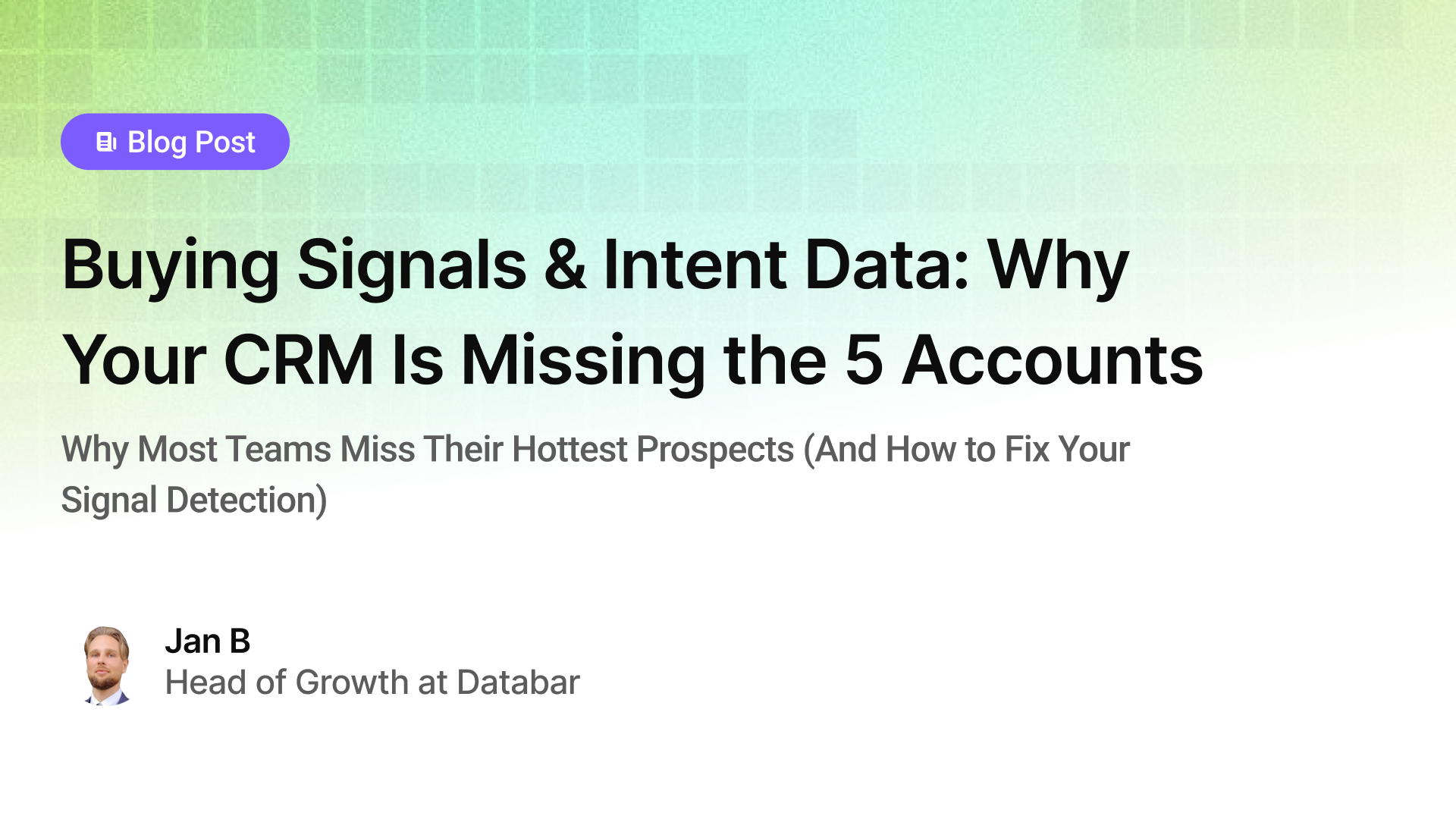
Buying Signals & Intent Data: Why Your CRM Is Missing the 5 Accounts
Why Most Teams Miss Their Hottest Prospects (And How to Fix Your Signal Detection)
by Jan, October 06, 2025

Lead Scoring & Account Segmentation: Why Most CRMs Get This Backward (And How to Fix It)
How to build a system that tells your team who to call, when, and why
by Jan, October 06, 2025
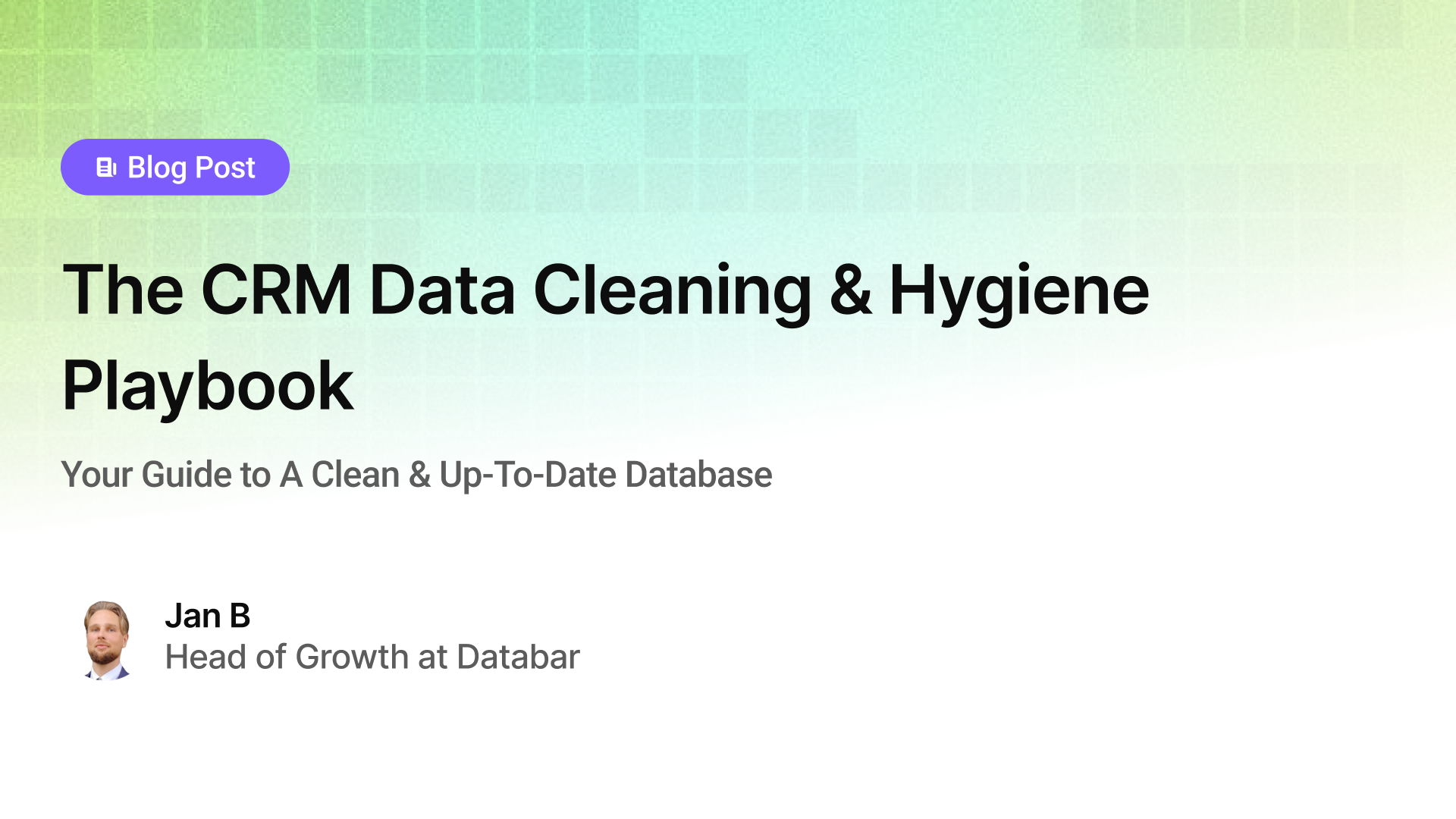
The CRM Data Cleaning & Hygiene Playbook
Your Guide to A Clean & Up-To-Date Database
by Jan, October 04, 2025
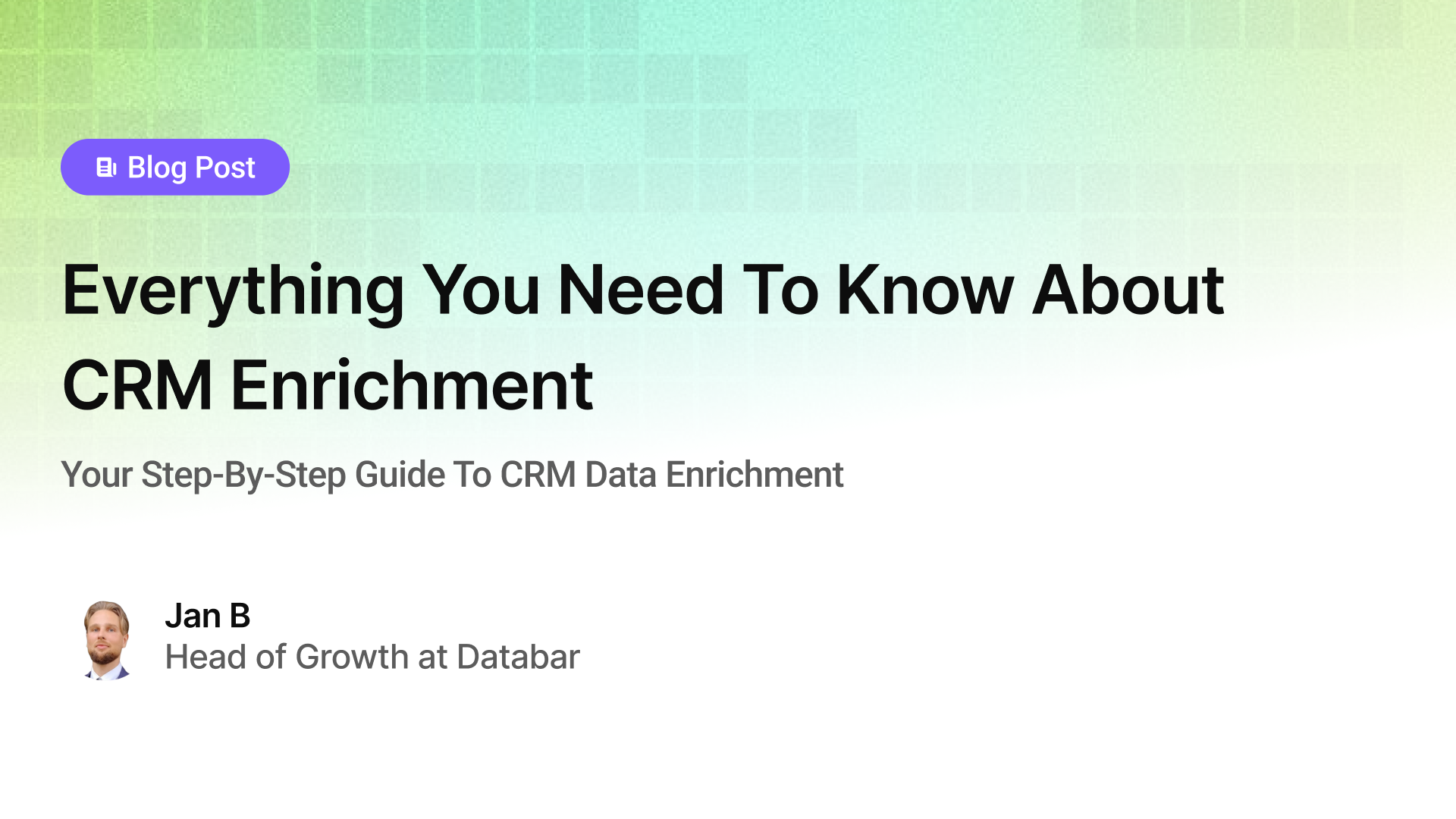
Everything You Need To Know About CRM Enrichment
Your Step-By-Step Guide To CRM Data Enrichment
by Jan, October 03, 2025

